Table of Contents
Introduction
Peanut Butter Statistics: Peanut butter, a well-loved spread globally, is primarily derived from finely ground roasted peanuts and may contain additives like salt, sweeteners, and emulsifiers. It supplies crucial nutrients such as protein, healthy fats, fiber, vitamins, and minerals.
Found in creamy, crunchy, natural, and organic forms, peanut butter is versatile and can serve various culinary purposes, including spreading, dipping, or cooking.
Its health benefits include serving as a valuable source of plant-based protein and heart-healthy fats, aiding digestion, and providing antioxidant properties.
Properly storing peanut butter in a cool, dry environment is essential to preserve its freshness and prevent spoilage.
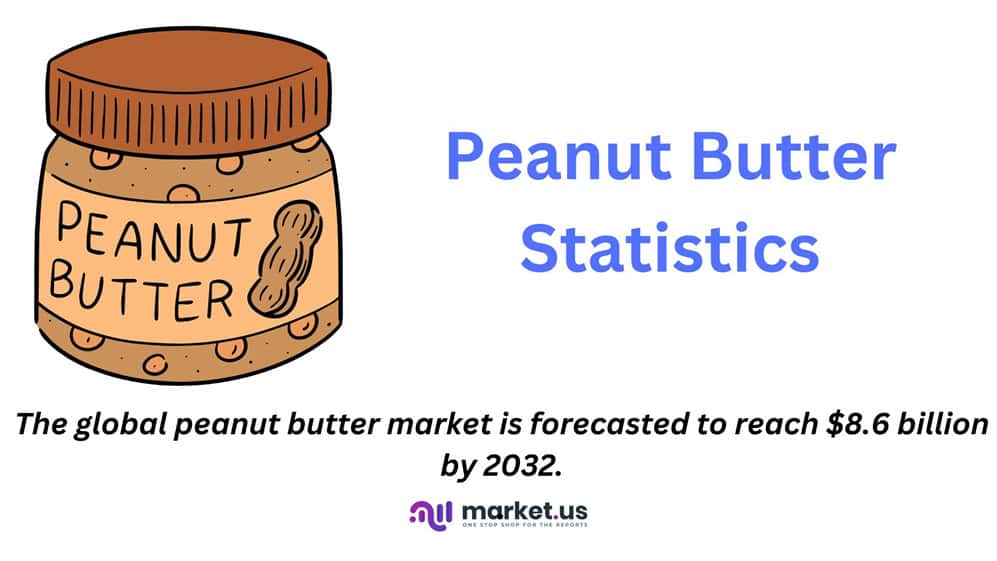
Editor’s Choice
- The global peanut butter market is predicted to reach $8.6 billion by 2032.
- Regular peanut butter holds the largest share at 38%, indicating its widespread popularity among consumers.
- France emerged as the leading importer in 2022, with an import value of USD 148.21 million, constituting approximately 9.81% of the total import value.
- India leads the export volume with a substantial shipment volume of 31,328 units, demonstrating its significant global peanut butter market presence.
- China stands out as the leading consumer of peanut butter, consuming a significant 4210 TMT in 2023, more than double the amount consumed by India, the second-largest consumer at 1494 TMT.
- In July 2023, the average export price of peanut butter reached $2,062 per ton, marking a slight increase of 1.6% compared to the previous month.
- According to the latest survey from Ask Your Target Market, most respondents, accounting for 76%, expressed a generally favorable opinion of peanut butter.
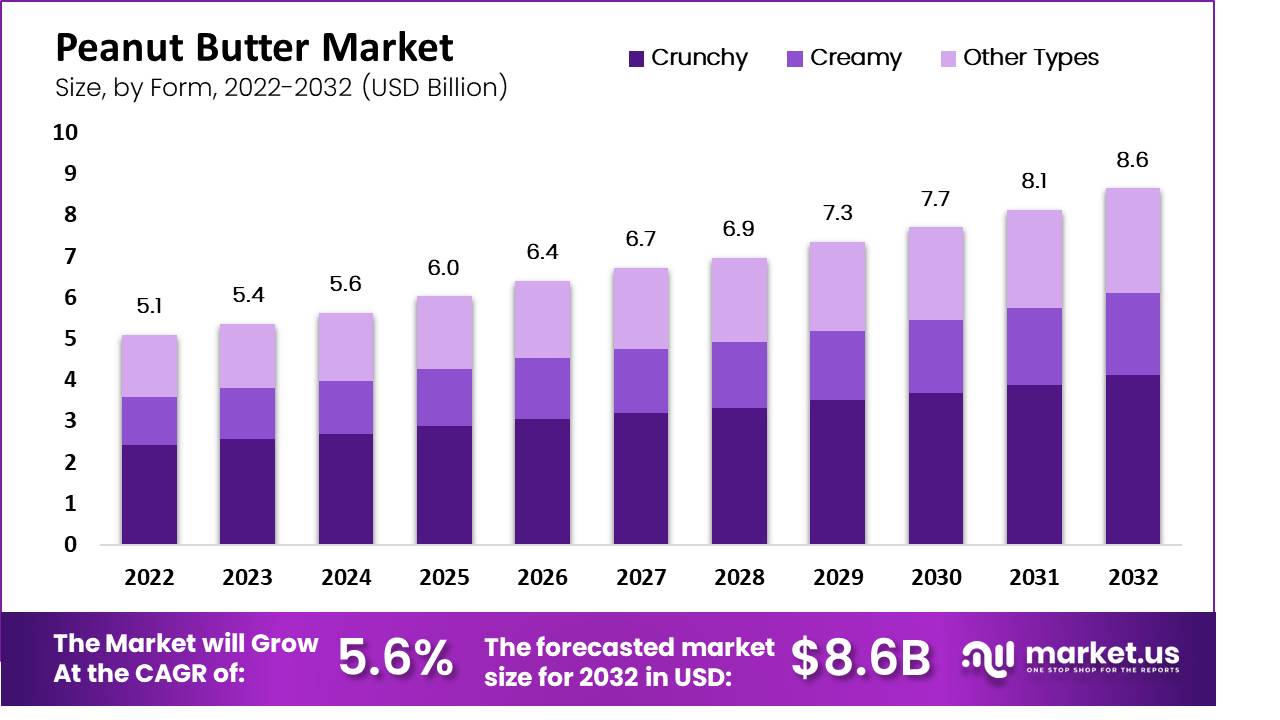
Global Peanut Butter Market Overview
Global Peanut Butter Market Size Statistics
- The global peanut butter market has demonstrated consistent growth in revenue over the years at a CAGR of 5.6%, reflecting its enduring popularity among consumers worldwide.
- Starting at $5.1 billion in 2022, the market revenue increased steadily to $5.4 billion in 2023 and $5.6 billion in 2024.
- The upward trend is projected to continue, with revenue reaching $6.0 billion in 2025, $6.4 billion in 2026, and $6.7 billion in 2027.
- By 2028, the market revenue is expected to reach $6.9 billion, followed by further growth to $7.3 billion in 2029, $7.7 billion in 2030, and $8.1 billion in 2031.
- The market is forecasted to expand further, reaching $8.6 billion by 2032.
- This sustained growth reflects the enduring demand for peanut butter and its versatility as a popular spread and ingredient in various culinary applications.
(Source: Market.us)
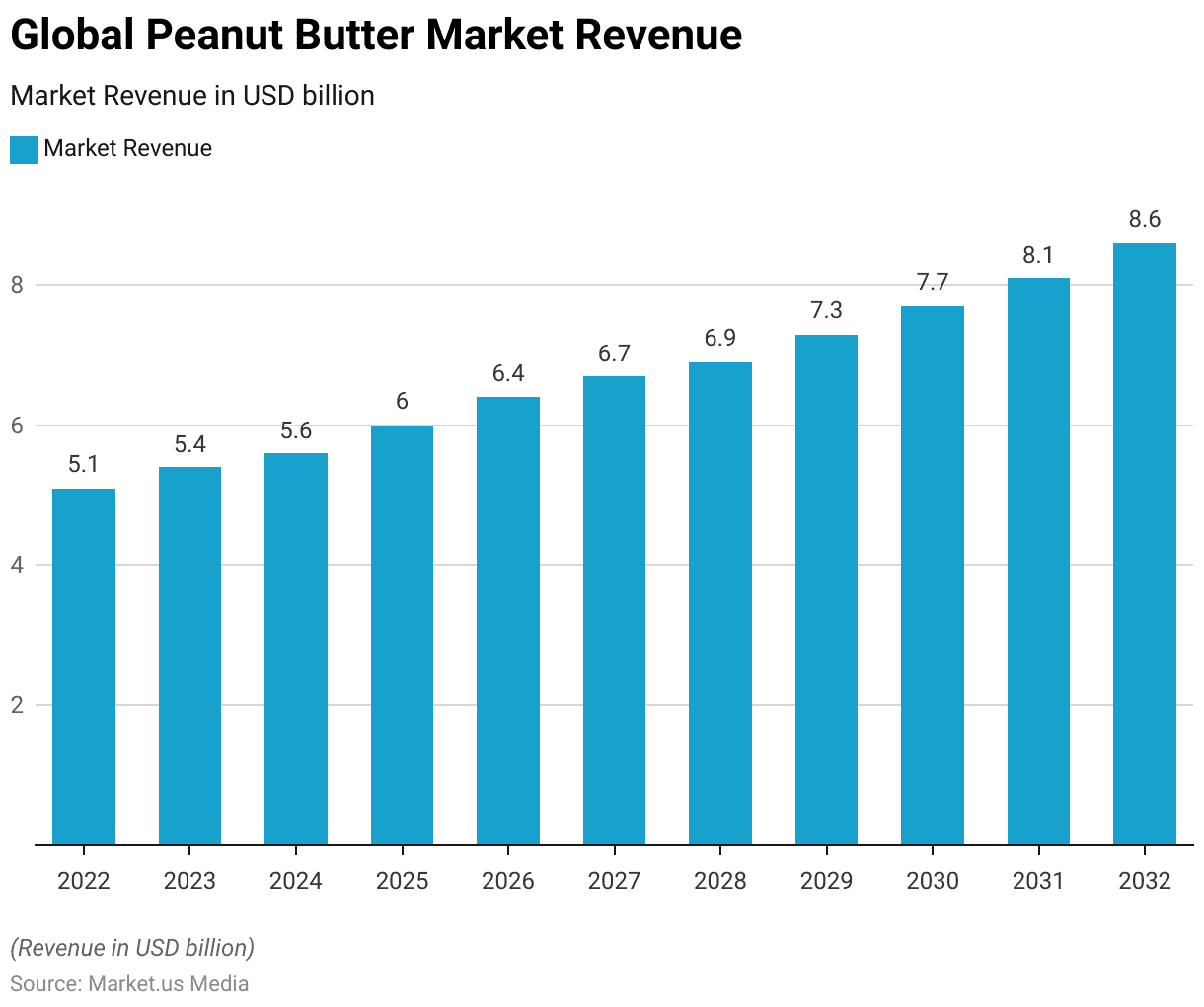
Peanut Butter Market Size – By Form Statistics
- The global peanut butter market, segmented by form, has shown consistent growth in revenue across different types over the forecast period.
- In 2022, the total market revenue stood at $5.1 billion, with crunchy peanut butter generating $2.43 billion, creamy peanut butter at $1.17 billion, and other types contributing $1.49 billion.
- Over the subsequent years, the market continued to expand, reaching $8.6 billion by 2032.
- The revenue from crunchy peanut butter increased steadily from $2.58 billion in 2023 to $4.10 billion in 2032.
- Similarly, revenue from creamy peanut butter grew from $1.24 billion in 2023 to $1.98 billion in 2032.
- Revenue from other types of peanut butter also saw significant growth, reaching $2.52 billion in 2032.
- This trend highlights the enduring popularity and diverse preferences within the global peanut butter market, with consumers favoring various forms and types.
(Source: Market.us)
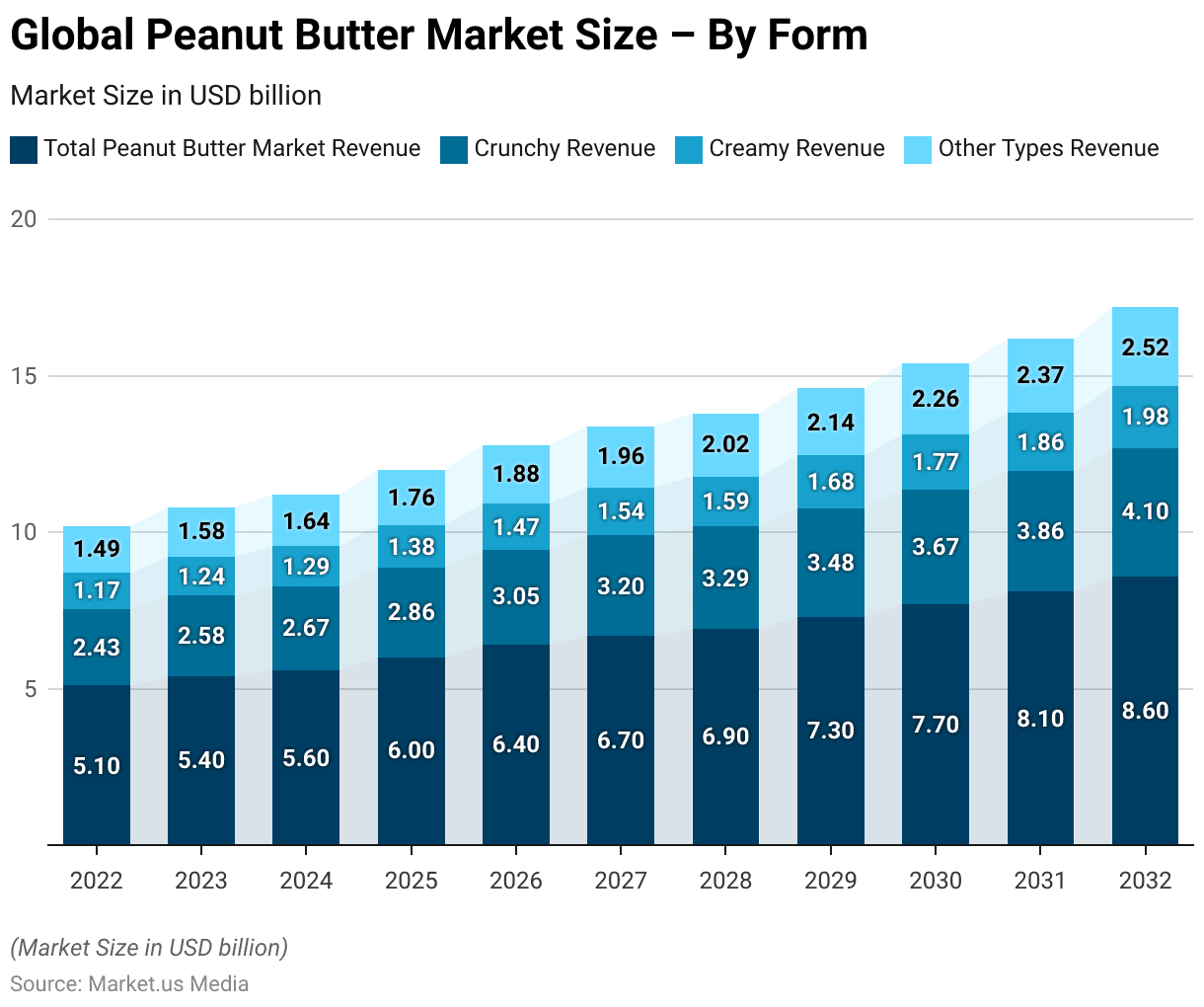
Global Peanut Butter Market Share – By Type Statistics
- The global peanut butter market is characterized by various types, each with its market share percentage.
- Regular peanut butter holds the largest share at 38%, indicating its widespread popularity among consumers.
- Following closely behind is low-sodium peanut butter, capturing 29% of the market share, appealing to health-conscious consumers seeking reduced sodium options.
- Plant-based peanut butter accounts for 18% of the market share, reflecting the growing trend toward plant-based diets.
- Lastly, low-sugar peanut butter holds a 15% market share, catering to consumers looking for alternatives with reduced sugar content.
- This segmentation demonstrates the diverse preferences within the peanut butter market, catering to a range of dietary needs and lifestyle choices.
(Source: Market.us)
Take advantage of our unbeatable offer - buy now!

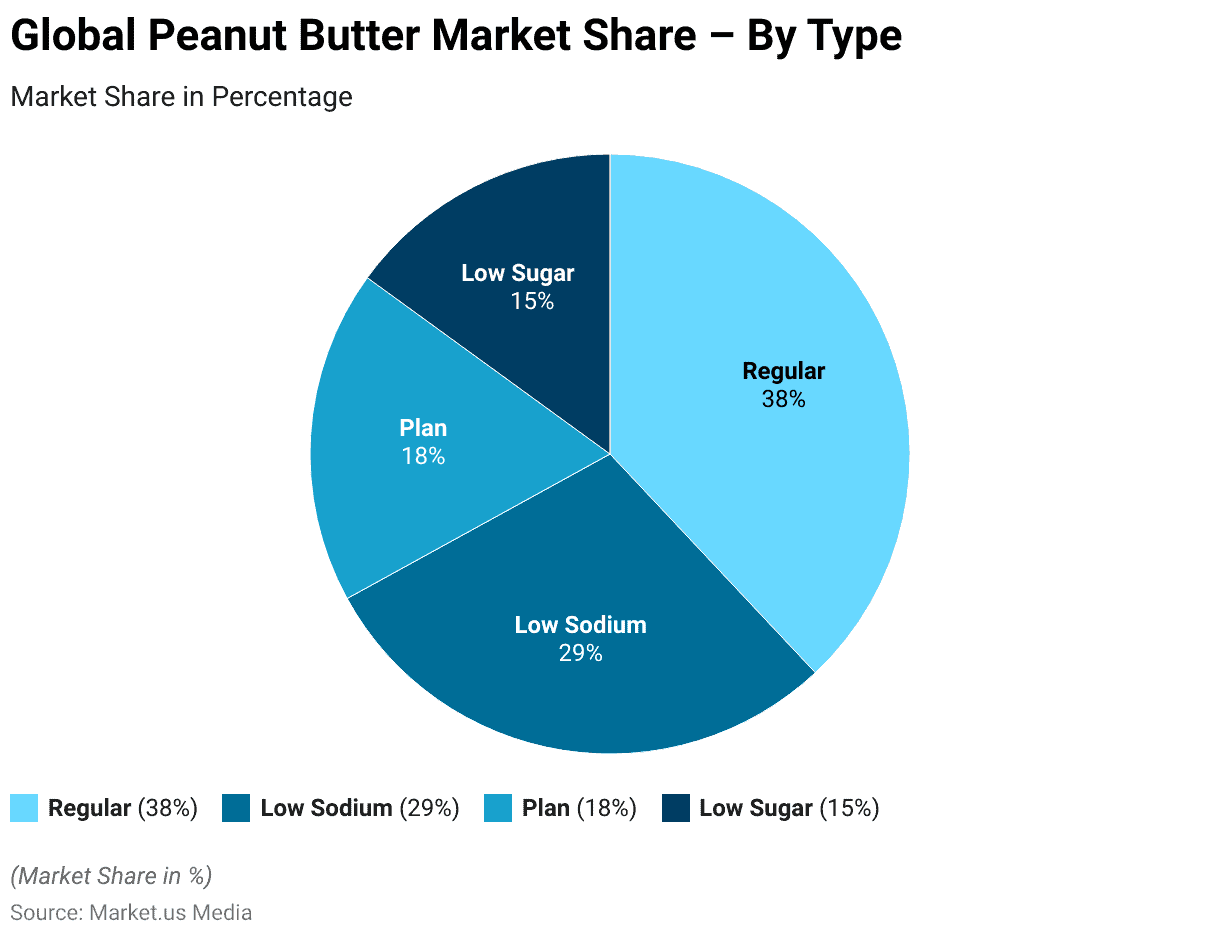
Peanut Butter Import Statistics
- In 2022, the global import statistics for peanut butter revealed a distribution of significant import values across several countries.
- France emerged as the leading importer with an import value of USD 148.21 million, constituting approximately 9.81% of the total import value.
- Not far behind, the United States followed closely with an import value of USD 147.24 million, comprising 9.75% of the import value.
- Japan and Germany also contributed notably to the import landscape, with import values of USD 108.23 million and USD 106.1 million, respectively, accounting for 7.16% and 7.02% of the total import value.
- Canada and the United Kingdom also maintained substantial shares, with import values of USD 85.31 million and USD 79.26 million, representing 5.65% and 5.25% of the total import value, respectively.
- Additionally, South Korea, Mexico, Poland, and Sweden were significant importers, each contributing varying proportions to the global import value.
- South Korea imported peanut butter worth USD 76.81 million, constituting 5.08% of the total import value. In contrast, Mexico, Poland, and Sweden imported peanut butter valued at USD 40.17 million, USD 38.83 million, and USD 33.92 million, respectively, contributing around 2-3% to the overall import value.
- These statistics underscore the widespread demand for peanut butter across diverse markets worldwide, with notable concentrations in key importing nations.
(Source: Tridge)
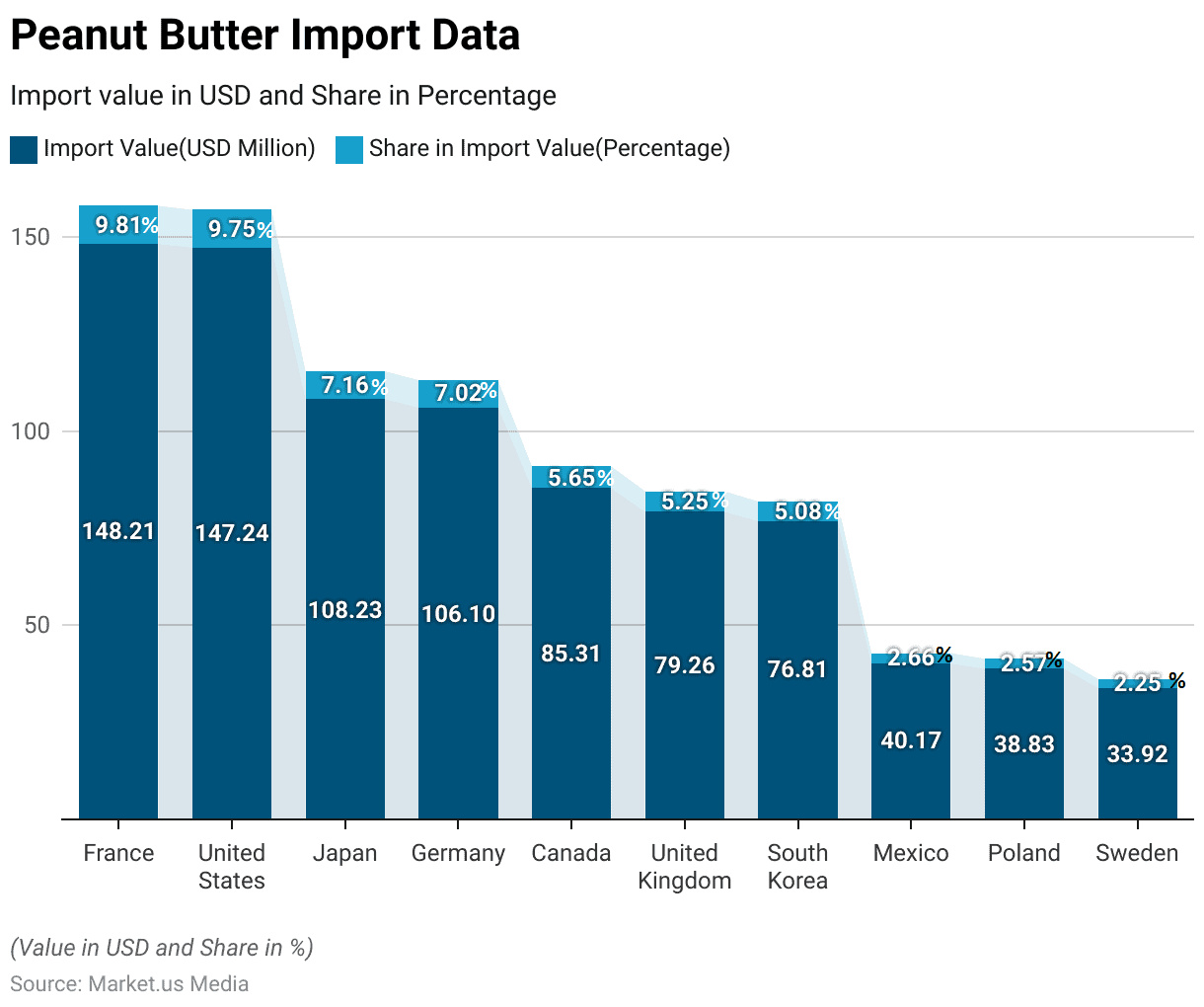
Peanut Butter Export Statistics
- Peanut butter export statistics reveal notable trends across various countries.
- India leads the pack with a substantial shipment volume of 31,328 units, demonstrating its significant global peanut butter market presence.
- Following closely behind, the United States and the Netherlands stand out with 14,441 and 14,010 shipments, respectively, showcasing their robust export capacities.
- South Africa emerges as another key player, contributing significantly with 12,881 shipments.
- Germany and Poland also exhibit notable export figures, with 11,345 and 10,208 shipments respectively.
- The United Kingdom, France, Italy, and Spain maintain respectable export volumes ranging from 5,952 to 5,209 shipments, indicating their international peanut butter trade participation.
- Additionally, Hungary, the Czech Republic, Austria, Belgium, and China demonstrate moderate export activities, with shipment numbers ranging from 4,235 to 3,691 units.
- These statistics reflect the global distribution of peanut butter exports, highlighting the diverse market landscape and the role of various countries in meeting international demand.
(Source: Volza)

Global Consumption of Peanut Butter
- China stands out as the leading consumer of peanut butter, consuming a significant 4210 TMT in 2023, more than double the amount consumed by India, the second-largest consumer at 1494 TMT.
- Following these two countries, peanut butter consumption drops notably in other parts of the world. For instance, Myanmar consumed 309 MT, while Sudan and Nigeria consumed 255 MT and 245 MT, respectively.
- Tanzania and Burkina Faso consumed 170 MT and 153 MT, respectively.
- The United States consumed 152 MT, slightly edging out Brazil’s consumption of 148 MT.
- In contrast, some countries had minimal peanut butter consumption in 2023, such as Japan with 1 TMT, Mexico with 2 MT, and Zambia with 3 MT.
- Togo and Guatemala each consumed 5 MT, while South Africa, Taiwan, Gambia, and Turkey consumed 6 MT, 7 MT, and 8 MT, respectively.
- The European Union collectively consumed 15 MT, indicating a relatively low consumption rate compared to other regions.
- Despite varying consumption levels, peanut butter and related products remain popular in many countries worldwide.
(Source: World Population Review)
Cost of Peanut Butter
- In July 2023, the average export price of peanut butter reached $2,062 per ton, marking a slight increase of 1.6% compared to the previous month.
- Overall, the export price exhibited a relatively stable trend over time. The most significant growth rate occurred in August 2022, with a month-on-month increase of 13%, reaching a peak of $2,338 per ton.
- However, average export prices remained lower from September 2022 to July 2023. Prices varied significantly depending on the destination country, with Afghanistan having the highest price at $3,247 per ton, while Turkey had one of the lowest average export prices at $1,653 per ton.
- From July 2022 to July 2023, the most notable price increase was observed in exports to Turkey (+2.3%), while prices for other major destinations experienced more modest growth rates.
- According to information from the U.S. Bureau of Labor Statistics, the cost of peanut butter increased by nearly 94% between 1997 and 2024, which equals about a $2.33 increase in price.
- Right now, the average national price for a pound of creamy peanut butter is about $2.48, although this can vary depending on where you are in the country due to how the data is collected.
- Over those years, peanut butter has been increasing by an average of about 2.49% each year, showing that it’s been getting more expensive.
- So, if you were buying peanut butter for $2.48 in 1997, you’d be paying almost $4.81 in 2024. It’s interesting to note that the price of peanut butter has been rising faster than the overall inflation rate, which was about 2.45% during that period.
(Source: IndexBox, U.S. Bureau of Labor Statistics)
Nutritional Value of Peanut Butter
- Peanut butter is a rich source of various nutrients. In terms of proximates, it contains 1.18 grams of water and provides 597 calories per serving.
- It is high in protein, with 22.5 grams per serving, and contains a significant amount of fat, totaling 51.1 grams.
- Regarding carbohydrates, peanut butter contains 22.3 grams of carbohydrates, including 4.8 grams of dietary fiber and 10.5 grams of total sugars.
- It also provides various minerals such as calcium (49 mg), iron (1.73 mg), magnesium (169 mg), phosphorus (339 mg), potassium (564 mg), sodium (429 mg), zinc (2.54 mg), copper (0.42 mg), and selenium (4.1 µg).
- Additionally, it contains several vitamins and other components, including thiamin (0.138 mg), riboflavin (0.191 mg), niacin (13.3 mg), vitamin B-6 (0.444 mg), folate (86 µg), choline (63 mg), and vitamin E (9.11 mg).
- Peanut butter is also rich in fatty acids, providing 10.1 grams of saturated fatty acids, 25.4 grams of monounsaturated fatty acids, and 12.3 grams of polyunsaturated fatty acids per serving.
- It is cholesterol-free and does not contain alcohol, caffeine, or theobromine.
(Source: U.S. Department of Agriculture)
Consumer Trends and Preferences
Flavours and Brands
- According to the latest survey from Ask Your Target Market, most respondents, accounting for 76%, expressed a generally favorable opinion of peanut butter.
- Only 6% indicated dislike, while 18% remained neutral.
- Among the various types of peanut butter, creamy emerged as the most favored, with 68% of respondents selecting it as their favorite.
- In comparison, 22% preferred crunchy peanut butter, while 9% favored extra crunchy.
- Additionally, 1% mentioned other favorite types, such as all-natural or a combination of creamy and crunchy.
- In terms of brands, Jif, Skippy, and Peter Pan were identified as the top favorites among respondents.
(Source: Ask Your Target Market)
Food Pairings
- People have plenty of ways to enjoy peanut butter. Most folks, about 76%, love classic peanut butter sandwiches.
- Then there’s a good chunk, around 36%, who enjoy peanut butter in cookies or baked goods.
- Another 29% have a sweet tooth and prefer it in candy—some, about 26%, just like it straight from the jar.
- For others, around 14%, it’s all about adding it to shakes or smoothies.
- And there’s a small group, about 10%, who get creative with peanut butter, like using it in sauces or pairing it with apples and celery.
(Source: Ask Your Target Market)
Alternative Options
- For individuals allergic to peanuts or seeking alternative options, many substitutes exist to explore.
- About 31% of respondents favor apple butter, while 28% enjoy almond butter.
- Hazelnut butter is liked by 22%, followed by cashew butter at 17%.
- Additionally, 14% opt for cookie butter, while 4% prefer soy butter.
- Other alternatives, like sun butter made from sunflowers, are favored by 3% of respondents.
- Nutella emerged as the most popular choice among the mentioned brands for peanut butter alternatives.
(Source: Ask Your Target Market)
Recent Developments
Acquisitions and Mergers:
- Acquisition of Small Peanut Butter Companies by Big Players:
- Large peanut butter manufacturers have been actively acquiring smaller companies to expand their market reach and diversify their product portfolio.
- Approximately 5 acquisitions were reported in the past year, indicating a trend toward consolidation in the industry.
New Product Launches:
- Introduction of Innovative Peanut Butter Varieties:
- Over 20 new peanut butter products were launched in the market, catering to diverse consumer preferences such as organic, natural, flavored, and specialty peanut butter spreads.
- Notable launches include gourmet peanut butter blends with exotic ingredients, appealing to health-conscious and adventurous consumers.
Funding and Investments:
- Venture Capital Funding in Peanut Butter Startups:
- Peanut butter startups attracted significant investment, with approximately $10 million injected into the sector in the last quarter alone.
- Investors are increasingly recognizing the growth potential of niche peanut butter brands offering unique formulations and sustainable sourcing practices.
Market Expansion Initiatives:
- International Expansion Strategies by Leading Brands:
- Major peanut butter manufacturers have embarked on aggressive expansion initiatives, targeting emerging markets in Asia-Pacific and Latin America.
- Market penetration efforts have resulted in a 15% increase in export volumes compared to the previous year.
Technological Advancements:
- Adoption of Automation and Robotics in Peanut Butter Production:
- Manufacturers are investing in advanced automation technologies to streamline production processes and enhance efficiency.
- Implementation of robotic systems has led to a 20% reduction in manufacturing costs and improved product consistency.
Health and Wellness Trends:
- Rising Demand for Natural and Organic Peanut Butter:
- Consumer preference for healthier alternatives has driven the demand for natural and organic peanut butter products.
- Sales of natural peanut butter varieties have surged by 25% year-on-year, reflecting a shift towards clean-label products.
Partnerships and Collaborations:
- Collaborative Efforts to Promote Sustainable Sourcing Practices:
- Peanut butter manufacturers are forming partnerships with sustainable agriculture initiatives and farmer cooperatives to ensure a transparent and ethical supply chain.
- Approximately 10% of peanut butter brands have pledged to source 100% of their peanuts from certified sustainable sources by 2025.
Conclusion
In conclusion, peanut butter is a widely beloved food item many worldwide enjoy. Its versatility, nutritional benefits, and diverse flavors contribute to its enduring popularity.
Despite the prevalence of peanut allergies and the availability of alternative nut and seed butter options, peanut butter continues to hold a special place in the hearts and pantries of consumers.
Whether spread on sandwiches, used in baking, or incorporated into various recipes, peanut butter remains a staple in households and a favorite choice for many.
As consumer preferences evolve and dietary trends shift, observing how the peanut butter market adapts to meet changing demands and preferences will be interesting. Overall, peanut butter’s enduring appeal underscores its status as a timeless classic in food products.
FAQs
Yes, peanut butter can be a healthy addition to your diet. It is a good source of protein, healthy fats, fiber, vitamins, and minerals. However, consuming it in moderation is essential as it is also high in calories.
Yes, most peanut butter brands are suitable for vegans as they are made solely from peanuts and do not contain any animal products.
Peanut butter is a common allergen, and individuals with peanut allergies should avoid it. Allergic reactions to peanuts can range from mild to severe and can be life-threatening in some cases.
Peanut butter is safe for most children and can be nutritious when introduced appropriately. However, avoiding giving peanut butter to infants under 12 months is essential, as it may increase the risk of developing peanut allergies.
Yes, there are various types of peanut butter available, including creamy (smooth), crunchy (chunky), natural (made with just peanuts and sometimes salt), and flavored varieties. Alternative nut and seed butter options exist for those with peanut allergies or preferences.
Discuss your needs with our analyst
Please share your requirements with more details so our analyst can check if they can solve your problem(s)



